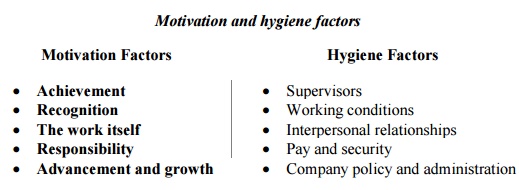Chapter: Mechanical : Total Quality Management (TQM) : Principles
HerzbergŌĆÖs Two Factor Theory
HerzbergŌĆÖs Two Factor Theory
This theory is also called motivation-hygiene
theory. This theory is based on two factors: 1. Motivation
factors or satisfiers, and 2. Hygiene factors or dissatisfiers. Various
motivation and hygiene factors are listed in Table.
Motivation
and hygiene factors

Motivation
Factors
Achievement
Recognition
The work itself
Responsibility
Advancement and growth
Hygiene
Factors
Supervisors
Working conditions
Interpersonal relationships
Pay and security
Company policy and administration
According to Herzberg,
maintenance or hygiene factors are necessary to maintain a reasonable level of
satisfaction among employees. These factors do not provide satisfaction to the
employees but their absence will dissatisfy them. Therefore these factors are
called dissatisfiers.
On the other hand, motivational
factors creates satisfaction to the workers at the time of presence
but their absence does not cause dissatisfaction. It can be noted that
HerzbergŌĆÖs dissatisfiers are roughly equivalent to MaslowŌĆÖs lower levels, and
the motivators are similar to the MaslowŌĆÖs
upper levels.
Thus the knowledge of motivation is required for
any organization to understand the utilization of employee involvement.
ACHIEVING
A MOTIVATED WORK FORCE
The building of a motivated work force if for the
most part an indirect process. Concepts to achieve a motivated work force are
as follows:
1.
Know thyself.
2.
Know your employees.
3.
Establish a positive attitude.
4.
Share the goals.
5.
Monitor progress.
6.
Develop interesting work.
├ś Job
rotation
├ś Job
enlargement
├ś Job
enrichment
7.
Communicate effectively
8.
Celebrate success.
EMPLOYEE
SURVEYS
Employee surveys help managers assess the current state of
employee relations, identify trends, measure the effectiveness of program
implementation, identify needed improvements, and increase communication
effectiveness.
STEP
1 The Quality Council to create a
multifunctional team
STEP
2 The Team will develop survey
instrument
STEP
3 Administer the survey
STEP
4 Results are compiled and analyzed
STEP
5 Determine areas for improvement
┬Ę Employee
involvement is creating an environment in which people have an impact on
decisions and actions that affect their jobs.
┬Ę
Tell: the supervisor mak es the
decision and announces it to staff. The supervisor provides complete
direction.
┬Ę
Sell: the supervisor makes the decision
and then attempts to gain commitment from staff by "selling"
the positive aspects of th e decision.
┬Ę Consult: the
supervisor i nvites input into a decision while retaining a uthority to make
the
final
decision herself.
┬Ę Join: the supervisor
inv ites employees to
make the decision
with the supervisor.
The
supervisor
considers her voice eq ual in the decision process.
To round
out the model, I add the following.
┬Ę
Delegate: the supervisor turns the
decision over to another party.
Seven Rules of Motivation
#1 Set a major goal, but
follow a path. The path has mini goals that go in m any directions.
When you learn to succeed at mini goals, you will be motivated to challenge
grand goals.

#2 Finish what you start. A half
finished project is of no use t o anyone. Quitting is a habit. Develop
the habit of finishing self-motivated projects.

#3 Socialize with others
of similar interest. Mutual support is motivating. We will develop
the attitudes of our five best friends. If they are losers, we will be a los
er. If they are winners, we will be a winner. To be a cowboy we must associate
with cowboys.

#4 Learn how t o learn.
Dependency on others for knowledge supports the habit of procrastination.
Man has the ability to learn without instructors. In fact, when we learn the
art of s elf-education we will find, if not create, opportunity to find success
beyond our wildest dreams.

#5 Harmonize natural
talent w ith interest that motivates. Natural talent cr eates motivation,
motivation creates persistence and persistence gets the job done.

#6 Increase knowledge of
subjects that inspires. The more we know about a subject,
the more we want to learn about it. A self-propelled upward spiral develops.

#7 Take risk. Failure and bouncing
back are elements of motivation. Failure is alearning tool. No one has
ever succeeded at anything worthwhile without a string of failures.
Related Topics